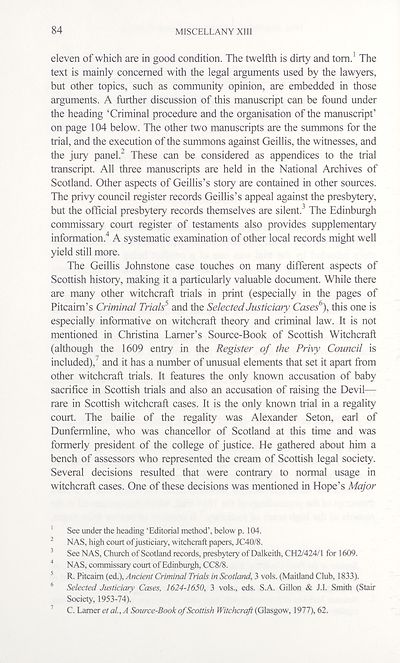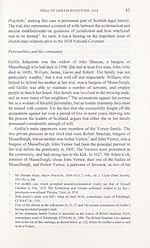Series 5 > Miscellany [of the Scottish History Society] XIII
(99) Page 84
Download files
Complete book:
Individual page:
Thumbnail gallery: Grid view | List view

84
MISCELLANY XIII
eleven of which are in good condition. The twelfth is dirty and tom.1 The
text is mainly concerned with the legal arguments used by the lawyers,
but other topics, such as community opinion, are embedded in those
arguments. A further discussion of this manuscript can be found under
the heading ‘Criminal procedure and the organisation of the manuscript’
on page 104 below. The other two manuscripts are the summons for the
trial, and the execution of the summons against Geillis, the witnesses, and
the jury panel.2 These can be considered as appendices to the trial
transcript. All three manuscripts are held in the National Archives of
Scotland. Other aspects of Geillis’s story are contained in other sources.
The privy council register records Geillis’s appeal against the presbytery,
but the official presbytery records themselves are silent.3 The Edinburgh
commissary court register of testaments also provides supplementary
information.4 A systematic examination of other local records might well
yield still more.
The Geillis Johnstone case touches on many different aspects of
Scottish history, making it a particularly valuable document. While there
are many other witchcraft trials in print (especially in the pages of
Pitcairn’s Criminal Trials5 and the Selected Justiciary Cases6), this one is
especially informative on witchcraft theory and criminal law. It is not
mentioned in Christina Earner’s Source-Book of Scottish Witchcraft
(although the 1609 entry in the Register of the Privy Council is
included),7 and it has a number of unusual elements that set it apart from
other witchcraft trials. It features the only known accusation of baby
sacrifice in Scottish trials and also an accusation of raising the Devil—
rare in Scottish witchcraft cases. It is the only known trial in a regality
court. The bailie of the regality was Alexander Seton, earl of
Dunfermline, who was chancellor of Scotland at this time and was
formerly president of the college of justice. He gathered about him a
bench of assessors who represented the cream of Scottish legal society.
Several decisions resulted that were contrary to normal usage in
witchcraft cases. One of these decisions was mentioned in Hope’s Major
1 See under the heading ‘Editorial method’, below p. 104.
2 NAS, high court of justiciary, witchcraft papers, JC40/8.
3 See NAS, Church of Scotland records, presbytery of Dalkeith, CH2/424/1 for 1609.
4 NAS, commissary court of Edinburgh, CC8/8.
5 R. Pitcairn (ed.), Ancient Criminal Trials in Scotland, 3 vols. (Maitland Club, 1833).
6 Selected Justiciary Cases, 1624-1650, 3 vols., eds. S.A. Gillon & J.I. Smith (Stair
Society, 1953-74).
7 C. Lamer et at, A Source-Book of Scottish Witchcraft (Glasgow, 1977), 62.
MISCELLANY XIII
eleven of which are in good condition. The twelfth is dirty and tom.1 The
text is mainly concerned with the legal arguments used by the lawyers,
but other topics, such as community opinion, are embedded in those
arguments. A further discussion of this manuscript can be found under
the heading ‘Criminal procedure and the organisation of the manuscript’
on page 104 below. The other two manuscripts are the summons for the
trial, and the execution of the summons against Geillis, the witnesses, and
the jury panel.2 These can be considered as appendices to the trial
transcript. All three manuscripts are held in the National Archives of
Scotland. Other aspects of Geillis’s story are contained in other sources.
The privy council register records Geillis’s appeal against the presbytery,
but the official presbytery records themselves are silent.3 The Edinburgh
commissary court register of testaments also provides supplementary
information.4 A systematic examination of other local records might well
yield still more.
The Geillis Johnstone case touches on many different aspects of
Scottish history, making it a particularly valuable document. While there
are many other witchcraft trials in print (especially in the pages of
Pitcairn’s Criminal Trials5 and the Selected Justiciary Cases6), this one is
especially informative on witchcraft theory and criminal law. It is not
mentioned in Christina Earner’s Source-Book of Scottish Witchcraft
(although the 1609 entry in the Register of the Privy Council is
included),7 and it has a number of unusual elements that set it apart from
other witchcraft trials. It features the only known accusation of baby
sacrifice in Scottish trials and also an accusation of raising the Devil—
rare in Scottish witchcraft cases. It is the only known trial in a regality
court. The bailie of the regality was Alexander Seton, earl of
Dunfermline, who was chancellor of Scotland at this time and was
formerly president of the college of justice. He gathered about him a
bench of assessors who represented the cream of Scottish legal society.
Several decisions resulted that were contrary to normal usage in
witchcraft cases. One of these decisions was mentioned in Hope’s Major
1 See under the heading ‘Editorial method’, below p. 104.
2 NAS, high court of justiciary, witchcraft papers, JC40/8.
3 See NAS, Church of Scotland records, presbytery of Dalkeith, CH2/424/1 for 1609.
4 NAS, commissary court of Edinburgh, CC8/8.
5 R. Pitcairn (ed.), Ancient Criminal Trials in Scotland, 3 vols. (Maitland Club, 1833).
6 Selected Justiciary Cases, 1624-1650, 3 vols., eds. S.A. Gillon & J.I. Smith (Stair
Society, 1953-74).
7 C. Lamer et at, A Source-Book of Scottish Witchcraft (Glasgow, 1977), 62.
Set display mode to:
![]() Universal Viewer |
Universal Viewer | ![]() Mirador |
Large image | Transcription
Mirador |
Large image | Transcription
Images and transcriptions on this page, including medium image downloads, may be used under the Creative Commons Attribution 4.0 International Licence unless otherwise stated. ![]()
| Scottish History Society volumes > Series 5 > Miscellany [of the Scottish History Society] XIII > (99) Page 84 |
|---|
| Permanent URL | https://digital.nls.uk/127314717 |
|---|
| Description | Over 180 volumes, published by the Scottish History Society, containing original sources on Scotland's history and people. With a wide range of subjects, the books collectively cover all periods from the 12th to 20th centuries, and reflect changing trends in Scottish history. Sources are accompanied by scholarly interpretation, references and bibliographies. Volumes are usually published annually, and more digitised volumes will be added as they become available. |
|---|


